
A militia patrol in the DRC.
The legitimacy of the government of the Democratic Republic of the Congo (DRC) in its peripheral regions has always been tenuous. Throughout the country’s history, the most vehement opposition to Kinshasa has frequently emerged from its most far-flung provinces, such as Kasai, Katanga, and the Kivus. Today, this fault line is being exacerbated by President Joseph Kabila’s decision to suspend elections and remain in office after the end of his constitutionally mandated term limit in December 2016.
In addition to triggering protests across many cities, the political crisis has revived and galvanized armed groups and militias in areas that harbor long-running grievances against the central government. Some insurgents have openly called on the President to step aside, even as their activities remain local. Others have expanded their attacks outside their traditional areas of operation in an apparent effort to exploit worsening grievances. Still others have focused their attacks on government personnel and facilities, including electoral commission offices, saying that preparations for new elections are meaningless as long as Kabila is a candidate.
In the DRC, the nexus between political and sectarian violence by armed militias is a key feature of political instability. This occurs in a climate of endemic corruption, weak or nonexistent institutions, and lack of trust between citizens and government. Nefarious actors thrive in this environment. This review highlights some of the patterns of violence by the estimated 70 armed groups active in the DRC—as uncertainty and anxiety over Kabila’s intentions intensify.
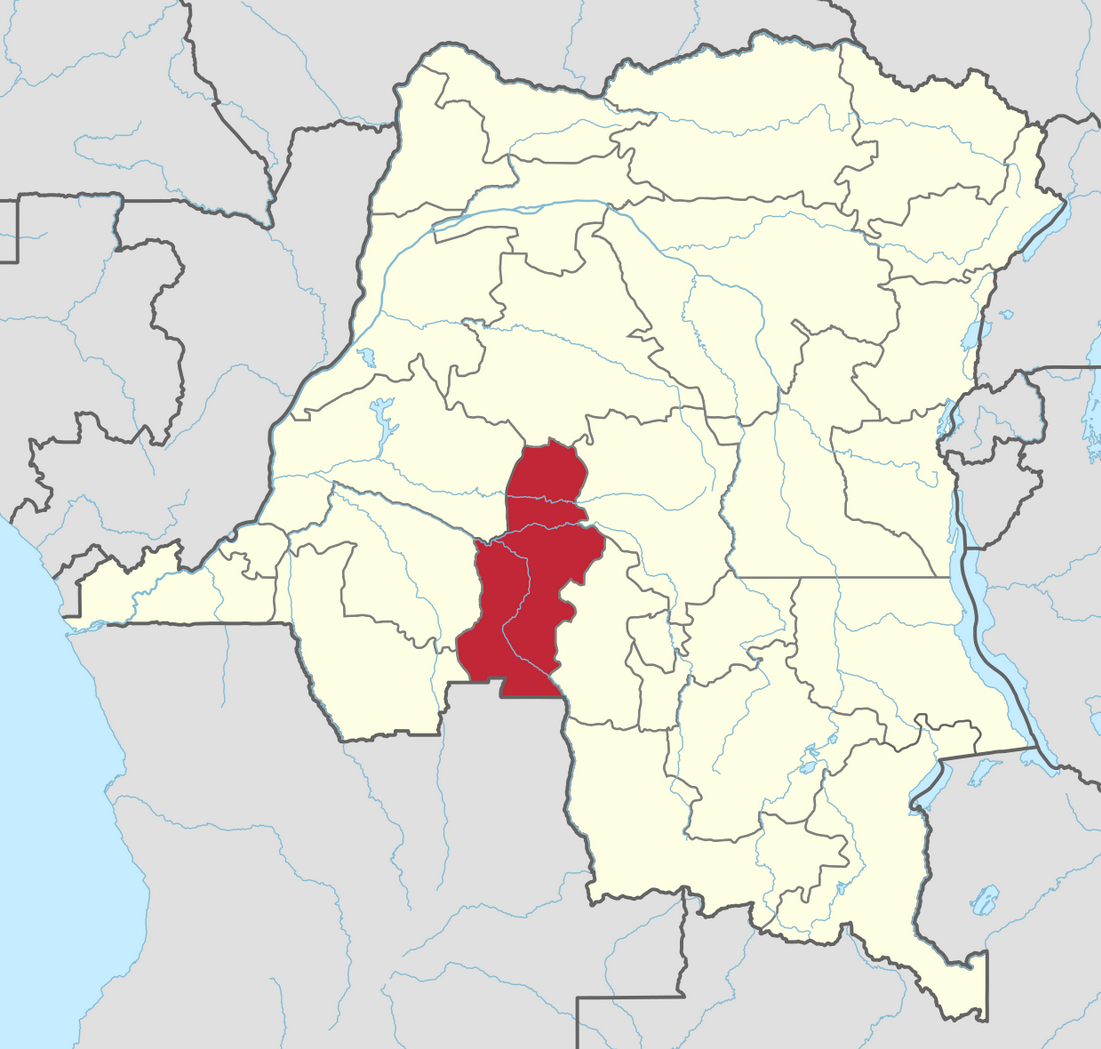 Kasai
Kasai
The south-central region of Kasai (approximately the size of Germany) is a traditional opposition stronghold and home to the late veteran opposition leader, Étienne Tshisekedi, popularly known as the “father of Congolese democracy.” It is also a microcosm of the center-periphery conflicts that have bedeviled the DRC since independence.
In the absence of central authority, traditional leaders have played a vital role throughout the DRC’s tumultuous history by mediating local disputes, maintaining law and order, and allocating resources, including land. They also perform spiritual functions. Traditional leaders are appointed according to local customs and then recognized by the state. To maintain their authority, they often align themselves to the regime—something that Jean-Pierre Mpandi, who was highly critical of the ruling party, refused to do.
Jean-Pierre Mpandi was killed in August 2016 in a skirmish with security forces. His followers launched the Kamwina Nsapu insurgency in November.
In 2016, the government refused to recognize Mpandi as the traditionally appointed Kamwina Nsapu—a title given to the hereditary leader of a chiefdom that covers large parts of Kasai-Central and extends into Angola—accusing him of maintaining close ties to Tshisekedi’s Union for Democracy and Social Progress. He was killed in August 2016 during a skirmish with security forces, and in November, his followers launched an insurgency named Kamwina Nsapu in response. They rallied supporters to rid Kasai of all central government representatives and institutions, a call once championed by their slain leader. They carried out both individual and coordinated attacks on police stations, army installations, and local offices of the Independent Electoral Commission (CENI).

Like other armed groups in the DRC, Kamwina Nsapu fighters undertake spiritual rituals and oaths to forge cohesion and discourage defections. With no identifiable leader, their demands are unclear, but the rebels have cunningly exploited public grievances about the current political crisis to curry loyalty. In February 2017, several fighters announced that the implementation of the Catholic Church-brokered agreement between the opposition and government was a core demand.
However, they then extended their attacks to Catholic churches and institutions. They also torched 600 schools and forcibly recruited hundreds of children as human shields.
The deadliest single episode of violence occurred in late March 2017 when Kamwina Nsapu rebels ambushed a police convoy and decapitated as many as 40 police officers. By mid-May, the insurgency had spread to Kasai’s neighboring provinces: Kasai-Oriental, Lomami, and Tanganyika. The government established a new military zone in these areas, but its poorly paid, led, and trained soldiers have been accused of using disproportionate force. In addition, the government brought in the rival Bana Mura ethnic militia, to augment the government’s counterinsurgency efforts. The Bana Mura, in turn, have been accused of “destroying entire villages, burning, shooting, and hacking to death villagers, among them babies and young children.” According to Catholic Church records more than 3,000 civilians have been killed in Kasai since the insurgency erupted. The UN has reported 38 mass graves and widespread violence against civilians.
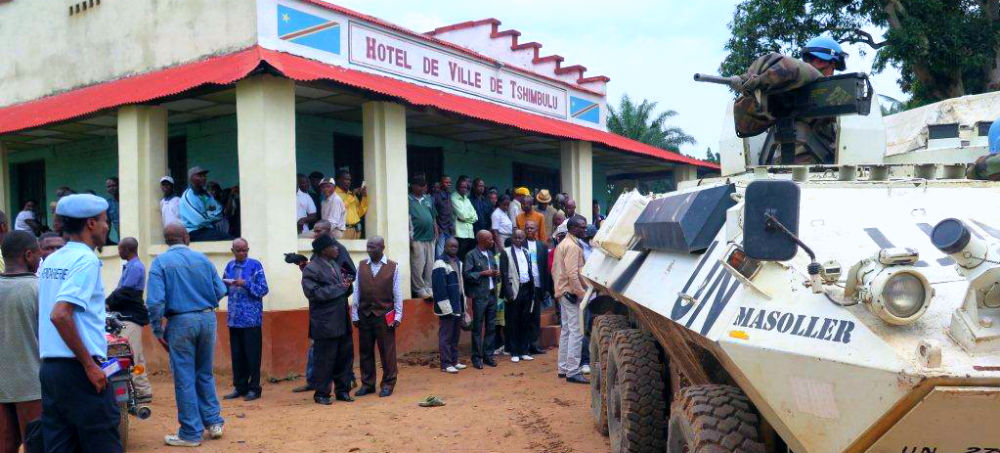
UN peacekeepers patrolling Tshimbulu, Kasaï-Central, on February 20, 2017, to promote dialogue in the region. Photo: Biliaminou Alao.
Bana Mura fighters have directed their attacks mainly against the Lulua-Luba community, which they accuse of supporting the Kamwina Nsapu. The Bana Mura has also committed gruesome atrocities against civilians perceived to be sympathetic to the central government, adding to the cauldron of sectarian violence. Reacting to the deteriorating situation, UN High Commissioner for Human Rights Zeid Ra’ad Al Hussein called the Kasai region “a landscape of horror.”
The government’s use of militias in Kasai and other hotspots as a means of extending its reach contributes to this cycle of violence. At the same time, this tactic undermines the security sector’s legitimacy and the respect for the rule of law. Likewise, the support provided to the rebels by some local politicians and businesspeople exemplifies the region’s wider discontent with the central government.
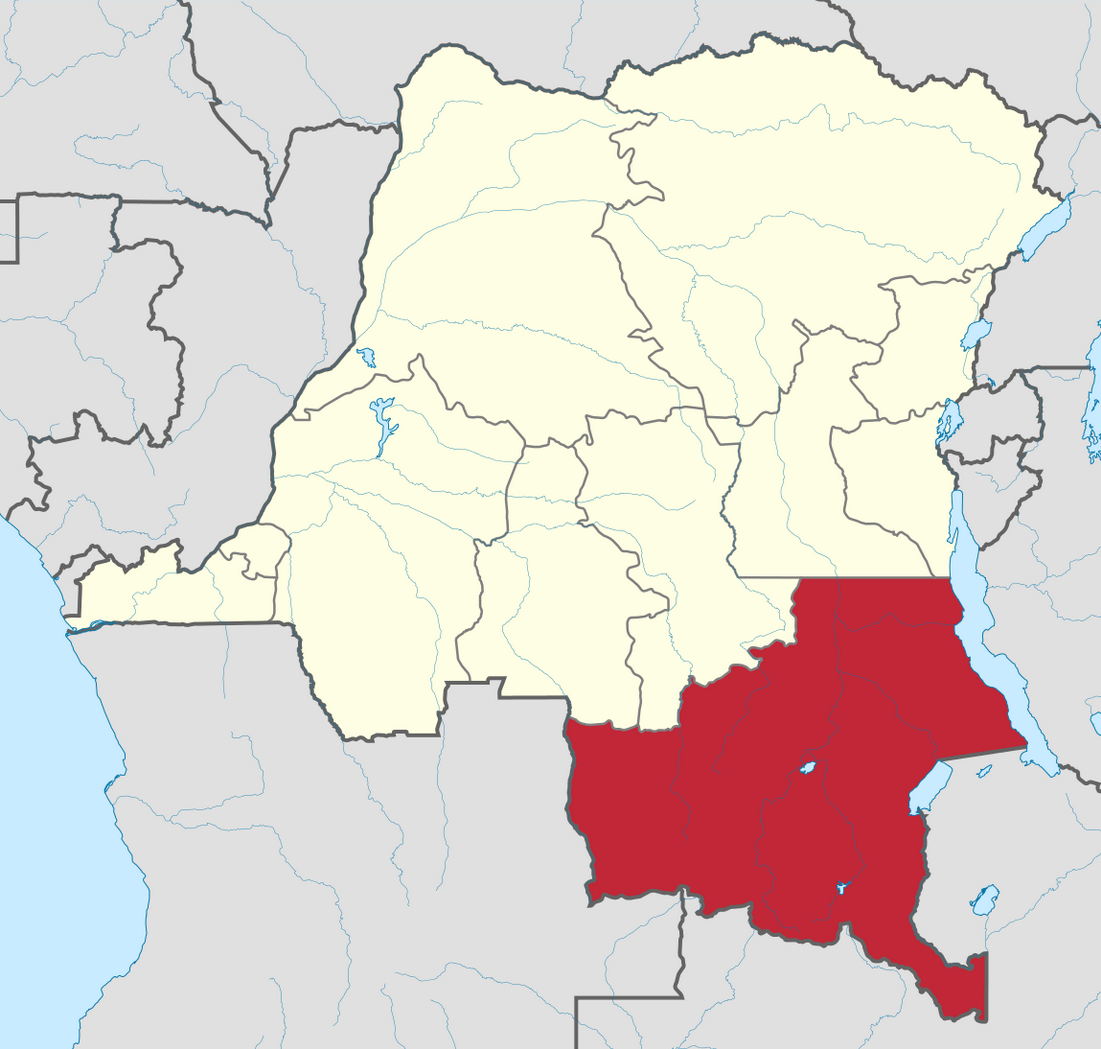 Katanga
Katanga
The lack of trust between Kinshasa and remote regions is a key driver of conflict in Katanga in southern DRC, another major opposition stronghold. It is the DRC’s richest province, accounting for 71 percent of the country’s revenue and 95 percent of its exports. Shortly after independence, Katanga was the seat of a vigorous, but ultimately unsuccessful, secessionist campaign and was later a key battleground in the revolt that overthrew Mobutu Sese Seko. The insurgents who unseated Mobutu were led by Laurent Kabila, the Katangan father of the current president. After Joseph Kabila took the reins of government, the region became a key regime stronghold and conduit for patronage.
The lack of trust between Kinshasa and remote regions is a key driver of conflict in Katanga in southern DRC.
This all changed in 2015 when, in the midst of a slump in mineral exports, ex-Kabila loyalists from the area began to speak out against the President’s maneuvers to derail elections. The government reacted by suddenly implementing découpage—a policy that had long been in place but never implemented—to increase the number of provinces from 11 to 26. Katanga was split into four provinces, a rushed and ill-planned move that Katangan elites saw as a divide and rule strategy. Découpage achieved the opposite of what Kabila had intended. Rather than dismantling the opposition, it intensified Katanga’s swing away from Kinshasa.
As grievances have spread, so too have fears that the violence that wracked this region in previous years might return. One of the armed groups most likely to exploit the simmering tensions is Mai Mai Kata Katanga (“Cut out Katanga”). It has overt links to Katangan identity issues, in particular the deep sense of alienation from the central administration, and it is linked to smaller secessionist groups, including Mai Mai Gideon (named for Gideon Kyungu, who also commands Mai Mai Kata Katanga) and Corak Kata Katanga (“Co-ordination for a Referendum on Self-Determination for Katanga”).

The “Triangle of Death” in Katanga province, DRC. Map data © 2017 Google.
Mai Mai Kata Katanga gained prominence in 2013 when its fighters stormed Katanga’s capital, Lubumbashi, and held it for several hours before surrendering at a UN base. That same year, the UN reported that violence between Mai Mai Kata Katanga and government forces spread to half of Katanga’s 22 territories and displaced a half million citizens. At the height of the fighting toward the end of 2013 the group’s fighters were concentrated in the northern parts of Katanga known as the “Triangle of Death,” where many still remain, even though the violence has since died down. Others are clustered around Sakania, on the Zambian border. While Katanga secessionists claim they are fighting to defend the region against exploitation by Kinshasa, UN investigators found that some of them are actually linked to prominent politicians aligned with the government. As is the case in Kasai, the government uses militias in its campaign against armed opponents.
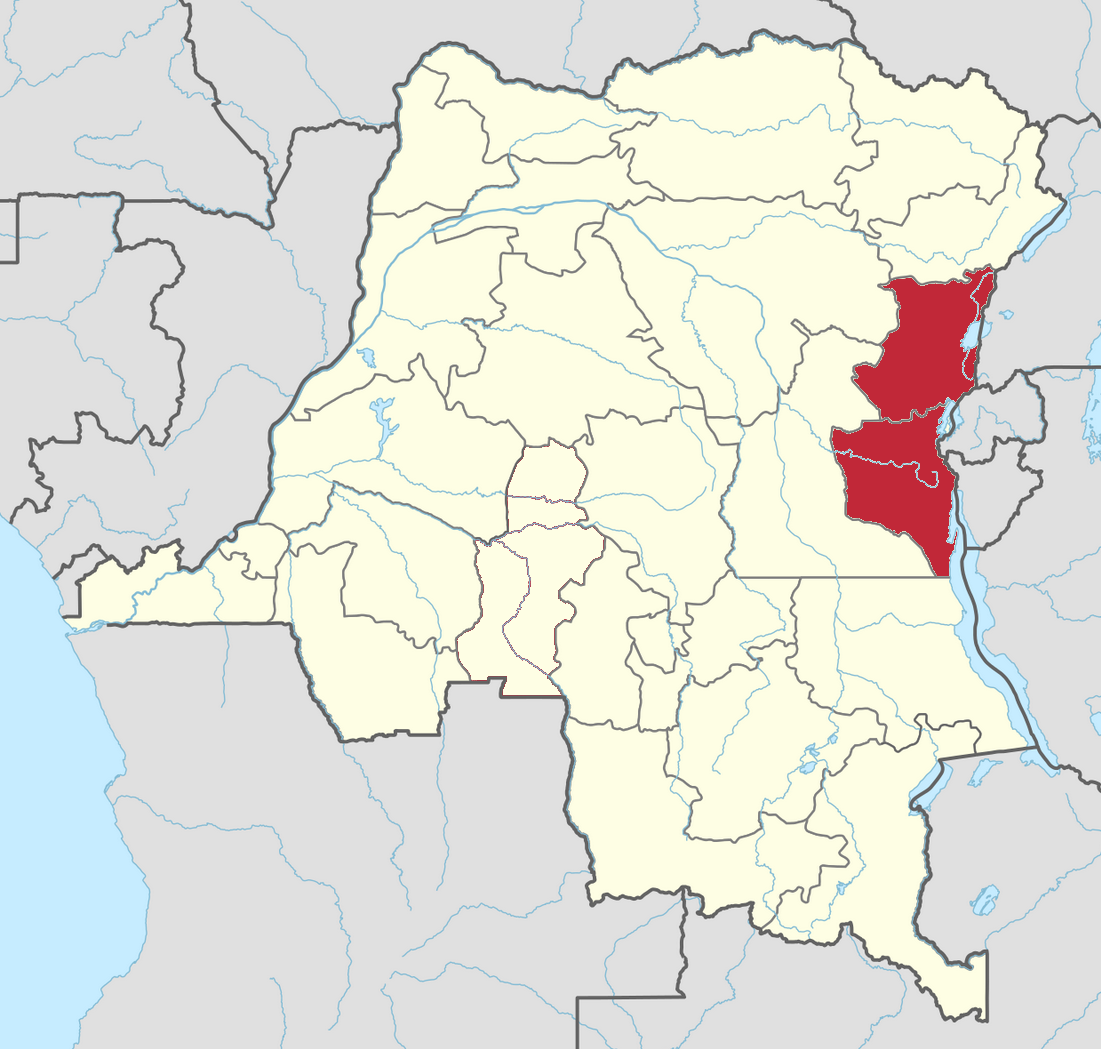 Eastern DRC
Eastern DRC
Congo’s two major wars (1996–1997 and 1998–2003) began in the east. The region is home to the vast majority of the country’s 70 armed groups, all pursuing shifting local and national agendas. Most of them are small, numbering less than 200 fighters, but the havoc they have caused over decades, especially in North and South Kivu, have made eastern DRC the epicenter of deadly violence and humanitarian crises. The Kivus, which cover 67,000 square kilometers and border Burundi, Rwanda, Tanzania, and Uganda, are also a hotbed of anti-government sentiment and activism (North Kivu alone is four times the size of Belgium). The violence in this vast region stems from feelings of marginalization from Kinshasa (over 1,500 km away) to grievances over the allocation of local resources such as land, representation in the central government, and the delivery of social services.
These grievances also have deep ethnic undertones that politicians and warlords manipulate to further their interests. One example is the citizenship of the Banyamulenge (“people of Mulenge”), which stoked some of the deadliest violence in the DRC. The Banyamulenge were originally Tutsi cattle-breeders who migrated to the Congolese town of Mulenge over a century ago. During periods of extreme unrest, Congolese authorities questioned their citizenship and backed local militias against them. The Banyamulenge and their local ethnic allies in turn launched several insurgencies, one of which, supported by Rwanda, Uganda, and Burundi, engulfed the entire country in crisis and led to the overthrow of the Mobutu government in 1998.
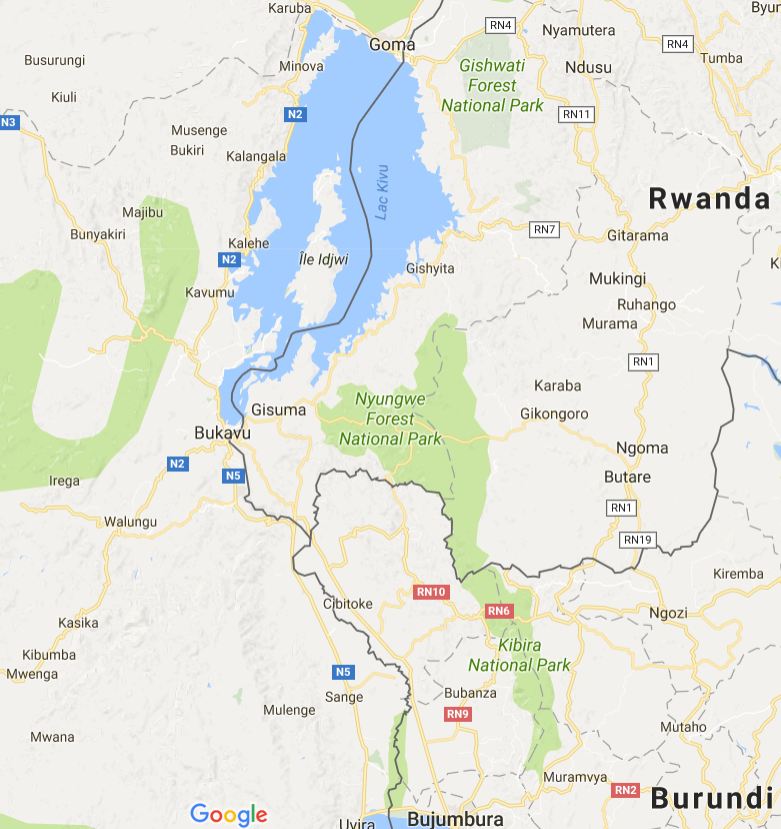
The eastern border of the DRC. Map © Google 2017.
More recently, a series of failed attempts to integrate rebels into the national army fueled a new wave of violence. It started out as a mutiny by mainly Banyamulenge officers who previously fought against the government. This group—the M23 (March 23 Movement)—took control of Goma, the capital of North Kivu, in November 2012, and rapidly gained ground before finally being defeated by the Congolese armed forces and the UN’s Force Intervention Brigade in November 2013.
Since that time, however, the M23 has begun to regroup and reorganize, at times taking advantage of public anger at the central government. In June 2016, fighting erupted in the south-central town of Kamina when security forces attempted to prevent former M23 fighters from leaving a camp for demobilized combatants.
Concurrent to these clashes, thousands took to the streets in nationwide protests against Kabila, including in Goma and the South Kivu capital of Bukavu, another flashpoint of rebel activity. In July 2017, clashes broke out again in the two provincial capitals between demonstrators and police. Protestors demanded that Kabila step aside and organize elections according to the December 2016 agreement mediated by the Catholic Church.
Although there are no known links between political activists and rebels, the surge in protests in these hotspots of deep anti-government sentiment created an opening that could be exploited by armed groups like the M23 seeking to reinvent themselves.
Nina Wilén of the Université libre de Bruxelles explains, “Even if the former M23 rebels do not seem to have any clear objective in reforming their group, the fact that Kabila has outstayed his welcome can make it easier for them to recruit new members in the Congo and legitimize their existence.”
The return of M23 could also fuel fresh sectarian violence and cause more fragmentation in an already tense political environment. The Tutsi-led movement is currently in direct conflict with local and regional Hutu militias, the most powerful of which is the Democratic Forces for the Liberation of Rwanda (FDLR). Numbering between 1,000 and 1,500, the FDLR was created by former members of the Interahamwe and ex–Rwandan Armed Forces responsible for the 1994 genocide against the Rwandan Tutsi. Its attacks cover large parts of North and South Kivu. Moreover, the group has links to other Hutu militias, and some local government officials. Both the M23 and FDLR have been accused of widespread war crimes in the DRC, including massacres targeting rival ethnic groups, mass rapes, and forced recruitment of children. Former M23 commander Jean Bosco Ntaganda is currently on trial at the International Criminal Court for war crimes. The ICC has issued a warrant for FDLR commander Sylvestre Mudacumura for similar charges.
The Allied Democratic Forces (ADF) of Uganda is another major militia operating in the region. Based in the Rwenzori Mountains along the border between Uganda and North Kivu, the ADF started out as an Islamist insurgency in 1996, committed to overthrowing the Ugandan government and establishing Islamic law. However, after being ejected from Uganda, the ADF became deeply entangled in North Kivu’s local dynamics. It has forged strong ties to local politicians and businessmen and engaged in a range of illicit activities, including weapons smuggling, timber harvesting, money transfers, and the illegal sale of forcefully seized land. There is little evidence of political or religious motivations in its current activities. The 2015 capture of its leader, Afghanistan-trained Jamil Mukulu, further negated its previous goals.
Most of the ADF’s attacks have centered on the town of Beni. In February 2016, it overran several army positions, executed civilians, and burned homes in Eringeti, north of Beni. It stormed the Tenambo, Nzanza, and Mamiki communities in an early morning raid on Beni’s outskirts in July of that year, and in August, it struck again, this time hacking to death 64 civilians and dumping their bodies in a nearby river. In all, ADF is responsible for more than 650 civilian deaths in and around Beni since 2014.
This death toll rose further in December 2017, when ADF fighters overran an army base near Beni, wounding more than 50 UN peacekeepers and killing 15 mostly Tanzanian troops. This was not the first time the ADF targeted UN personnel. In 2015, it attacked a base of the Force Intervention Brigade (FIB) consisting of Tanzanian, and South African troops operating under the UN Organization Stabilization Mission in DRC (MONUSCO). One Malawian peacekeeper was killed and another seriously wounded. In November 2017, ADF again attacked a FIB/MONUSCO base in Mamundioma, northeast of Beni, killing two peacekeepers and injuring several others. Created by the UN Security Council in March 2013 the FIB is the first UN combat force authorized to carry out targeted offensive operations against armed groups in eastern DRC.
Mai Mai Militias
A sizeable number of Congolese armed groups countrywide organize themselves under the Mai Mai moniker, a term that signifies resistance against outside agendas that are seen as hindering indigenous communities. But the concept often takes on different political and cultural meanings depending on the local and national contexts. During the Second Congo War, the local militias in the east fighting incursions by Ugandan, Burundian, and Rwandan troops all identified themselves as Mai Mai Congolese nationalists.
While many Mai Mai outfits retain this nationalist identity—mostly in opposition to immigrant communities and ethnic Rwandans—the vast majority operate as local franchises pursuing a mix of agendas ranging from the control of resources to extortion, illegal taxation, and banditry. Some operate as religious cults, while others function as private militias loyal to political and business interests. Still others are focused on protecting their territories from rival Mai Mai.
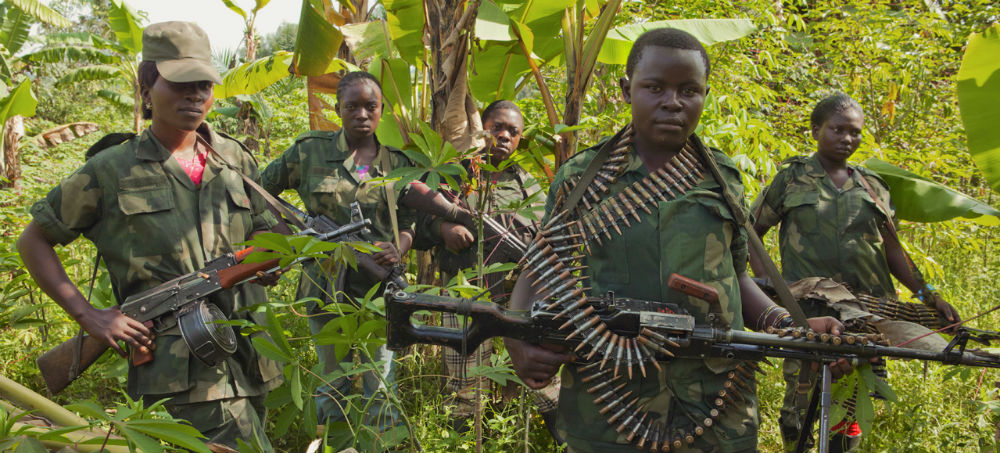
Female fighters from a Mai Mai group in North Kivu, DRC. Photo: Matchbox Media Collective.
Some of the larger Mai Mai outfits are explicitly political in outlook, and therefore more likely to exploit the crisis between Kabila and his opponents to stoke more violence. The Congolese Resistance Patriots (PARECO–Mai Mai) and the Alliance for a Free and Sovereign Congo (Mai Mai APLS) both made—but ultimately aborted—moves to become political parties. Similarly, Mai Mai Kifuafua abandoned efforts to integrate into the military and returned to its positions in North Kivu, where it has operated since 2009.
Mai Mai Nyatura (“hit them hard”) targets Tutsi communities in North Kivu in coordination with FDLR. In response, Tutsi communities and their ethnic allies formed Raia Mutomboki (“outraged citizens”) as a self-defense unit. By 2014, Raia Mutomboki had morphed into an array of militias deployed across a swath of territory the size of Belgium in North and South Kivu and parts of Ituri Province in the northeast.
Bunia, the capital of Ituri, saw some of the deadliest violence during the Second Congo War, pitting the pastoralist Hema against Lendu farmers. The European Union’s Operation Artemis, a peace enforcement force, quelled the violence, leading to the disbandment of the Hema-dominated Union of Congolese Patriots and Lendu-dominated Nationalist Integrationist Front. Both groups subsequently joined the political process. However, the Lendu-dominated Patriotic Resistance in Ituri rejected integration and remains active. Bunia is now an epicenter of protests against the delayed presidential elections. In January 2017, the Patriotic Resistance launched a series of attacks on CENI facilities and stepped up recruitment in Bunia and surrounding areas.
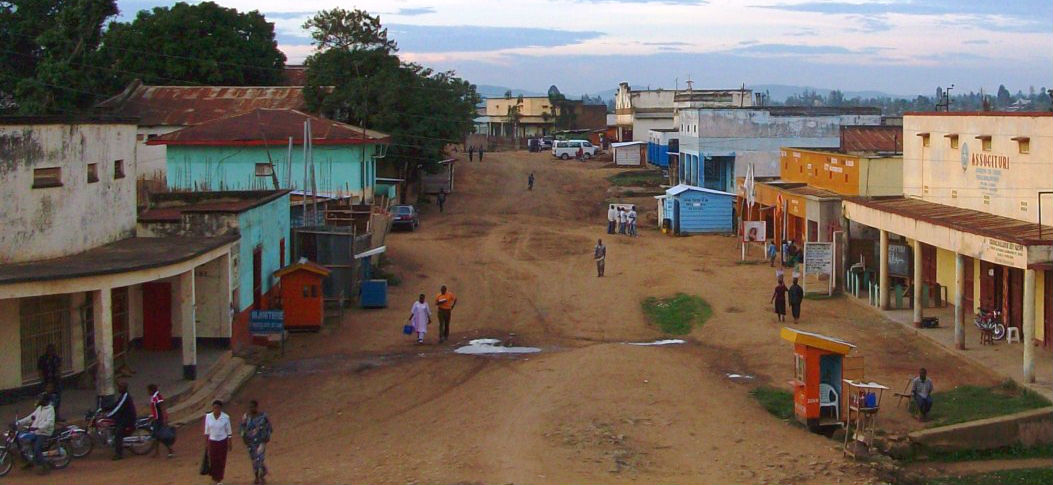
Bunia, Ituri province, DRC. Photo: Dans.
Coming Apart at the Seams
Congo’s vicious cycle of political mismanagement, widespread grievances, and sectarian violence is once again threatening to tear the country apart. With no political deal in sight, the uncertainty is creating conditions for the growth and expansion of new insurgencies and giving old insurgencies a new lease of life.
The government’s use of militias to attack insurgents appears to be only creating more chaos, while weakening government credibility.
In September, a group of Mai Mai militias operating under the banner of the National Peoples Coalition for the Sovereignty of the Congo (CNPSC), also known as ‘l’Alliance de l’article 64’ (“AA.64,” in reference to Article 64 of the Congolese constitution) captured Kigongo town in South Kivu on the DRC-Burundi border. The offensive was a continuation of an uprising that CNPSC launched symbolically on June 30—DRC’s Independence Day—to “liberate Congo from a President who has lost legitimacy.”
Some of these armed groups are targeting their attacks on the electoral infrastructure—largely seen as an expression of anger at Kabila’s unwillingness to implement the December 2016 political agreement. In South Kivu, armed groups, including Raia Mutomboki and Nyatura, have attacked voter registration centers. In January 2017, Mai Mai Gideon fighters attacked suspected FDLR sympathizers to prevent them from registering to vote and also abducted CENI agents. Targeted violence against voter registration has also occurred in Ituri, North Kivu, and Tanganyika.
The government’s use of militias to attack insurgents appears to be only creating more chaos, while weakening government credibility. Consequently, strengthening political legitimacy and adherence to the constitution will be a vital foundation from which to try and regain support from across the periphery and convince armed groups to lay down their arms.
Additional Resources
- Africa Center for Strategic Studies, “A Looming Calamity in the Democratic Republic of the Congo,” Spotlight, September 13, 2016.
- Africa Center for Strategic Studies, “The DRC’s Oversight Institutions: How Independent?” Spotlight, October 5, 2016.
- Africa Center for Strategic Studies, “The Role of Civil Society in Averting Instability in the DRC,” Spotlight, November 15, 2016.
- Africa Center for Strategic Studies, “Security Sector Institutions and the DRC’s Political Crisis,” Spotlight, December 20, 2016.
- Africa Center for Strategic Studies, “The Role of External Actors in the DRC Crisis,” Spotlight, January 12, 2017.
- Jason Stearns, Judith Verweijen, and Maria Eriksson Baaz, “The National Army and Armed Groups in the Eastern Congo: Untangling the Gordian knot of Insecurity,” Special Report, Rift Valley Institute, 2013.
- Clement Mweyang Aapengnuo, “Misinterpreting Ethnic Conflicts in Africa,” Africa Security Brief No. 4, Africa Center for Strategic Studies, April 2010.
More on: Conflict Prevention or Mitigation Peacekeeping Security Sector Governance Democratic Republic of the Congo

